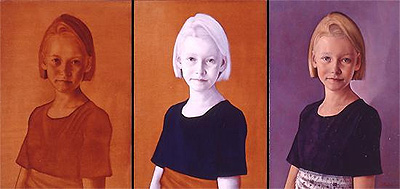Painting Technique
Writing about one's technique is a tricky business. No one portrait follows a standard formula, and to suggest that a successful painting can be created in a rigid step-by-step manner is quite ludicrous. Whatever individual method is adopted though, it is wise to have some sort of system. The following description is my system, described in the most general of terms:
Ground Preparation and Underdrawing
A panel or canvas is prepared with several thin layers of gesso, sanded between layers. The structure of the gesso, whether applied with a brush or by some other means, plays an important role in determining whether the portrait is painterly, or refined in appearance. A thin layer of burnt umber is laid down evenly as a ground and allowed to dry thoroughly. Working from a suitable photo, the head is modeled in thin layers of burnt umber with a fair amount of detail giving the illusion of light moving across the form from a single light source. Each layer is kept transparent even in the darkest shadowed areas.

Underpainting
Once the drawing is completely dry, the head is built up in combinations of transparent zinc white and opaque titanium white. The thickest areas of white are where the light strikes the figure directly. Conversely, the shadows are painted with transparent white over the brown underdrawing producing, bluish shadows. Varying the thickness of the white paint creates the form of the head as the light strikes it. The hair and the clothing are also painted in a similar way with emphasis on texture and light fall.
Glazing
When the underpainting is complete, transparent color is applied in thin layers first in the shadowed areas and then gradually to the lightest areas. Several layers of transparent color are applied to suggest the transparent nature of skin. If the shadows become too brown, then a thin layer of zinc white is re-applied, creating a bluish-area which is re-glazed when dry. In cases where the underpainting is not strong enough, the entire head will have to be repainted in white or "highed-up," and later re-glazed. A neutral background is laid in loosely, revealing the brownish-orange underpainting in places, giving more depth to the picture. The background is also glazed to strengthen the shadows, bring out the figure and soften contours.
This technique is not a forgiving one. It entails making a long series
of correct decisions. Making corrections after glazing is difficult indeed.
Considerable patience is required to work with layers that must completely
dry before continuing. It is therefore understandable why few artists
employ this exacting and time-consuming method.